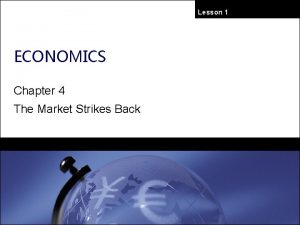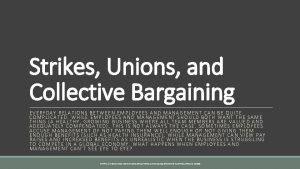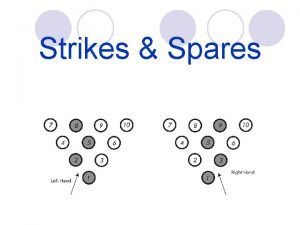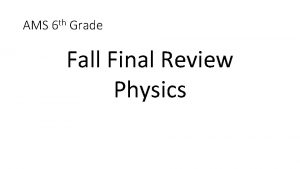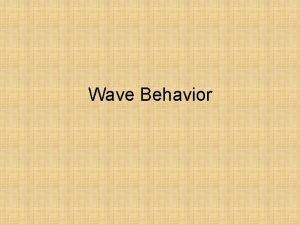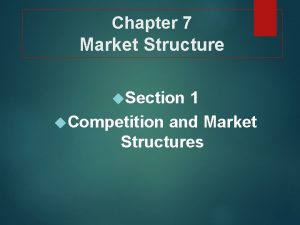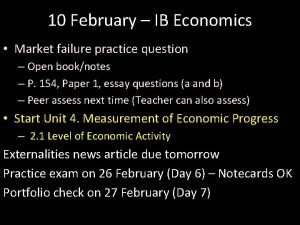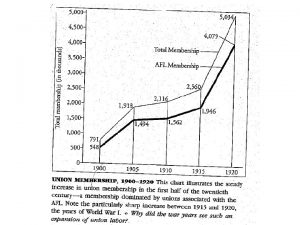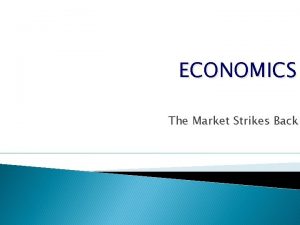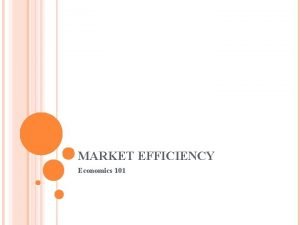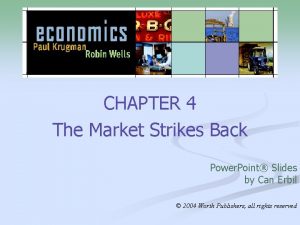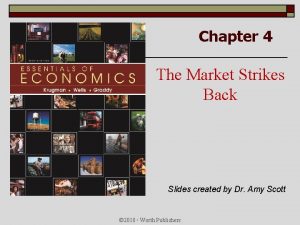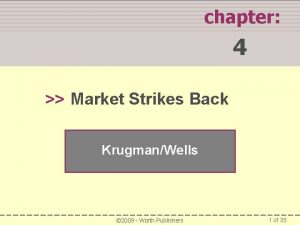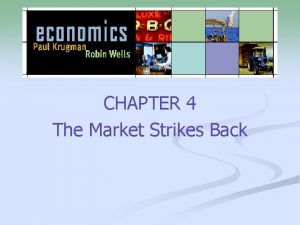Lesson 1 ECONOMICS Chapter 4 The Market Strikes



























- Slides: 27

Lesson 1 ECONOMICS Chapter 4 The Market Strikes Back

Review: Supply and Demand • The previous lesson focused on demand supply, we studied the demand curve and the supply curve… S P P D Quantity 1 ECONOMICS Chapter 4 Quantity 1

Review: Supply and Demand • …and the market equilibrium: S P Peq D Qeq 2 ECONOMICS Chapter 4 Quantity 2

Practice More Supply and Demand • As a Group answer the Questions that follow the Headlines. – What is the market? – Has supply or demand change? – How will this change affect price? – Are there ay other markets that could be affected by this news event? 3 ECONOMICS Chapter 4 3

Practice More Supply and Demand • NOW EACH GROUP CREATE YOUR ON HEADLINE FOR ANOTHER GROUP TO ANSWER. – What is the market? – Has supply or demand change? – How will this change affect price? – Are there ay other markets that could be affected by this news event? 4 ECONOMICS Chapter 4 4

Economic Equilibrium • Equilibrium is the market clearing price and involves the most efficient choice – Producers and consumers make the most of their limited resources at the least cost – Therefore, producers and consumers act in their own economic self-interest when moving towards equilibrium • At this point the number demanded equals the number supplied 5 ECONOMICS Chapter 4 5

$60 supply $50 $40 equilibriu m Price $30 $20 dema nd $10 6 ECONOMICS Chapter 4 100 200 Units 300 400 500 6

Shortage and Surplus • Shortage occurs when a good or service is priced below the market clearing price – Supply < Demand (Not enough Goods for the Number of Buyers) • Surplus occurs when a good or service is priced above the market clearing price – Supply > Demand (Not enough Buyers for the Number of Goods) 7 ECONOMICS Chapter 4 7

P 2 Surplus Shortage P 3 8 ECONOMICS Chapter 4 8

• Not all markets are ones in which price is allowed to move freely. Governments may decide to set prices for various reasons. These government set prices may be different than the market clearing price. Talk to your face partner about examples/reasons when the government might step in and regular the price of goods and services. 9 ECONOMICS Chapter 4 9

• Not all markets are ones in which price is allowed to move freely. Governments may decide to set prices for various reasons. These government set prices may be different than the market clearing price. Talk to your face partner 0: 01 0: 02 0: 03 0: 04 0: 05 0: 06 0: 07 0: 08 0: 09 0: 10 0: 11 0: 12 0: 13 0: 14 0: 15 0: 16 0: 17 0: 18 0: 19 0: 20 0: 21 0: 22 0: 23 0: 24 0: 25 0: 26 0: 27 0: 28 0: 29 0: 30 0: 31 0: 32 0: 33 0: 34 0: 35 0: 36 0: 37 0: 38 0: 39 0: 40 0: 41 0: 42 0: 43 0: 44 0: 45 0: 46 0: 47 0: 48 0: 49 0: 50 0: 51 0: 52 0: 53 0: 54 0: 55 0: 56 0: 57 0: 58 0: 59 1: 00 1: 01 1: 02 1: 03 1: 04 1: 05 1: 06 1: 07 1: 08 1: 09 1: 10 1: 11 1: 12 1: 13 1: 14 1: 15 1: 16 1: 17 1: 18 1: 19 1: 20 1: 21 1: 22 1: 23 1: 24 1: 25 1: 26 1: 27 1: 28 1: 29 1: 30 1: 31 1: 32 1: 33 1: 34 1: 35 1: 36 1: 37 1: 38 1: 39 1: 40 1: 41 1: 42 1: 43 1: 44 1: 45 1: 46 1: 47 1: 48 1: 49 1: 50 1: 51 1: 52 1: 53 1: 54 1: 55 1: 56 1: 57 1: 58 1: 59 2: 00 End 10 ECONOMICS Chapter 4 about examples/reasons when the government might step in and regular the price of goods and services. 10

Price controls • Price controls are legal restrictions on how high or low a market price may go. • 2 kinds of price controls: 1. Price Ceilings: a maximum price sellers are allowed to charge for a good. It’s an upper limit for the price. 2. Price Floors: a minimum price buyers are required to pay for a good. It’s a lower limit for the price. 11 ECONOMICS Chapter 4 11

Price controls Why Price controls? • During crisis times, emergencies or wars the government wants to protect the consumers from rapidly increasing prices. • If the equilibrium wage given by supply and demand for low skilled workers is below poverty level, the government can set a minimum wage. 12 ECONOMICS Chapter 4 12

Price controls: price ceilings • Equilibrium Pric e • Price ceiling D S e 4 S D 4 3 3 Price Ceiling 2 2 Shortage 100 200 13 ECONOMICS Chapter 4 Quantity of icecreams 100 200 800 Quantity of icecreams 13

Price controls: Price Celings in Apartments 14 ECONOMICS Chapter 4 14

Price controls: price floors • Equilibrium Pric e D • Price floor Pric S e 4 D Surplus S 4 3 3 Price Floors 2 2 100 200 15 ECONOMICS Chapter 4 Quantity of icecreams 100 200 600 Quantity of icecreams 15

16 ECONOMICS Chapter 4 16

Price controls: price ceilings • Because of these ceilings, we are faced with a shortage. • The shortage will lead to inefficiencies: A market or an economy is inefficient if there are missed opportunities: some people could be made better off without making other people worse off. 17 ECONOMICS Chapter 4 17

Price controls: price ceilings • Let’s take a look at the different possible inefficiencies: 1. Inefficient Allocation to Consumers 2. Wasted Resources 3. Inefficiently Low Quality 4. Black Markets 18 ECONOMICS Chapter 4 18

Price controls: price ceilings Inefficient Allocation to Consumers • Price ceilings can lead to inefficiency in the form of inefficient allocation to consumers: people who really want the good and are willing to pay a high price don’t get it, and those who are not so interested in the good and are only willing to pay a low price do get it. • Example: rent control. In such case people get the appartment usually through luck or personal connections. 19 ECONOMICS Chapter 4 19

Price controls: price ceilings Wasted Resources • Price ceilings typically lead to inefficiency in the form of wasted resources: people spend money, time and expend effort in order to deal with the shortages caused by the price ceiling. • You waste a lot of time looking for a good (e. g. an appartment) in case of shortage, the time has it’s value! You can work or just rest, do something better than look for a good you’ can’t find. 20 ECONOMICS Chapter 4 20

Price controls: price ceilings Inefficiently Low Quality • Price ceilings often lead to inefficiency in that the goods being offered are of inefficiently low quality • In case of rent controls, the landlords will not improve the conditions of the appartments, there is no incentive since the rental fee is low but the main reason is that since there is a shortage, people are willing to rent the apartment as it is, even in bad condition! 21 ECONOMICS Chapter 4 21

Price controls: price ceilings Black Markets • A black market is a market in which goods or services are bought and sold illegally—either because it is illegal to sell them at all or because the prices charged are legally prohibited by a price ceiling. • If someone for example bribes (gives extra money) to the apartment owners he will get the apartment, but the honest people that don’t break the law will never find one this way! 22 ECONOMICS Chapter 4 22

Price controls: price floors • Price Floors: a minimum price buyers are required to pay for a good. I’ts a lower limit for the price. • The minimum wage is a legal floor on the wage rate, which is the market price of labor. 23 ECONOMICS Chapter 4 23

Price controls: price floors Why a Price Floor Causes Inefficiency • Inefficient Allocation of Sales Among Sellers • Price floors lead to inefficient allocation of sales among sellers: those who would be willing to sell the good at the lowest price are not always those who actually manage to sell it. Example: Farm Subsidies Wasted Resources Like a price ceiling, a price floor generates inefficiency by wasting resources. 24 ECONOMICS Chapter 4 24

Subsidies • The United States subsidizes certain industries like farming • Subsidies are a form of financial assistance paid to a business or economic sector. Most subsidies are made by the government to producers or distributors in an industry to prevent the decline of that industry 25 ECONOMICS Chapter 4 25

Price controls: price floors Inefficiently High Quality and Quantity Price floors often lead to inefficiency in that goods of inefficiently high quality are offered: sellers offer high-quality goods at a high price, even though buyers would prefer a lower quality at a lower price. Or the seller offers more quantity than is demanded and we are left with a surplus 26 ECONOMICS Chapter 4 26
 Japan strikes in the pacific
Japan strikes in the pacific Market leader challenger follower nicher
Market leader challenger follower nicher Market segmentation lesson plan
Market segmentation lesson plan Inefficiently low quality definition economics
Inefficiently low quality definition economics Economics and business economics maastricht
Economics and business economics maastricht Mathematical economics vs non mathematical economics
Mathematical economics vs non mathematical economics Strikes unions and collective bargaining
Strikes unions and collective bargaining Strikes and spares
Strikes and spares Properties of light
Properties of light Transparent materials examples
Transparent materials examples Chapter 5 projectile motion
Chapter 5 projectile motion 1912 strikes an inspector calls
1912 strikes an inspector calls A car traveling at 100 km/h strikes an unfortunate bug
A car traveling at 100 km/h strikes an unfortunate bug When a firefly hits a bus
When a firefly hits a bus F
F Reflection refraction diffraction
Reflection refraction diffraction Light strikes
Light strikes Reflection is when a wave strikes an object and
Reflection is when a wave strikes an object and Gilded age labor strikes
Gilded age labor strikes What is the 3 strikes law
What is the 3 strikes law Pink panther strikes again soundtrack
Pink panther strikes again soundtrack There are great numbers of deer around here
There are great numbers of deer around here Light strikes
Light strikes The sun the empire strikes back
The sun the empire strikes back A golf ball strikes a hard smooth floor
A golf ball strikes a hard smooth floor Chapter 7 lesson 1 competition and market structures
Chapter 7 lesson 1 competition and market structures Ib economics market failure questions
Ib economics market failure questions Lesson 1 your total health
Lesson 1 your total health



